Understanding the SMETA Audit Report: A Complete Section-by-Section Overview
The SMETA audit, or Sedex Members Ethical Trade Audit, provides an in-depth evaluation of responsible supply chain practices. The SMETA audit report offers valuable insights into your suppliers’ conduct and knowing how to interpret the findings is crucial to leveraging a SMETA audit effectively.
In this article, we’ll break down the SMETA audit report’s main sections and explain how to use its insights to ensure compliance and strengthen your ethical practices.
What Are the Main Sections of the SMETA Audit Report?
The SMETA audit report is structured to provide a comprehensive view of your supply chain’s ethical compliance. The SMETA audit can be conducted as either a 2-pillar or a 4-pillar audit. The 4-pillar audit is more comprehensive as it includes additional sections on Environmental Performance and Business Ethics. This article will focus on the 4-pillar audit to provide a complete view of the ethical standards that may be assessed in a SMETA audit. Here’s an overview of the layout of the SMETA audit report:
1. Audit Overview
This section provides a summary of the audit scope, methodology, and key findings. It includes a Non-Compliance Table, which gives a quick view of non-compliance issues identified across all areas.
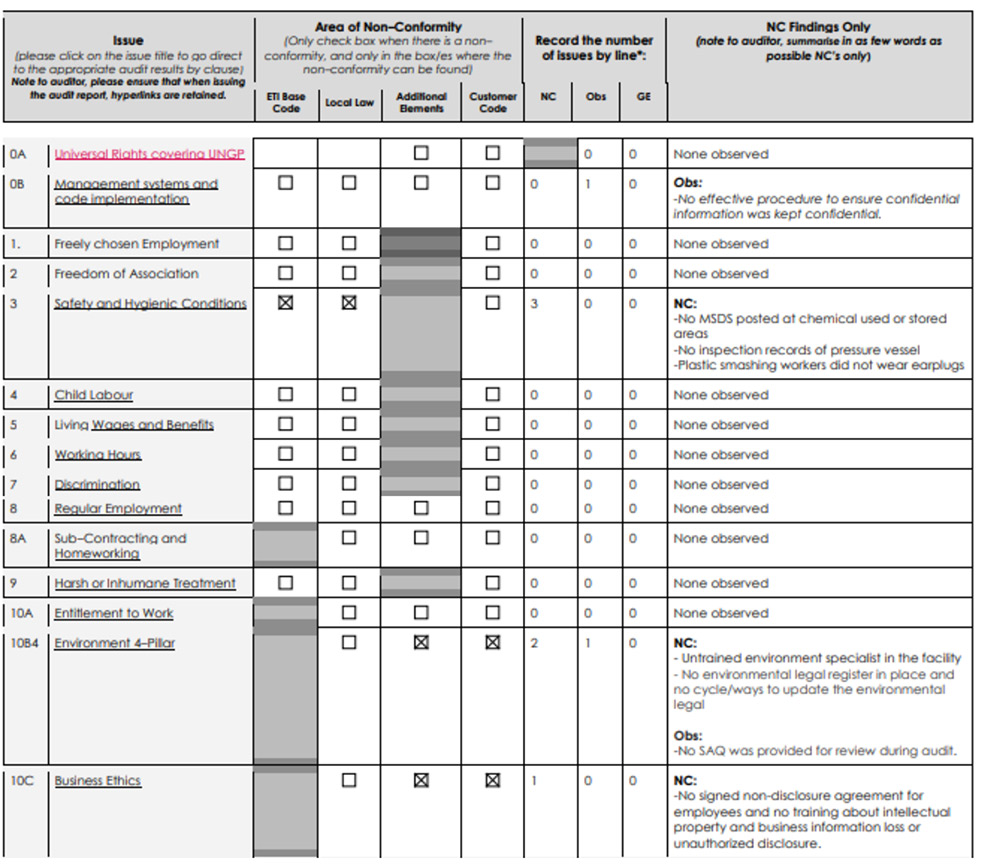
Example of Non-Compliance Summary Table, showing each section assessed in a SMETA audit (“Issue” column).

Example of Non-Compliance Summary. This summarizes all areas of non-compliance found in the audit.
2. ETI Base Code Assessments
The main section of the audit report is organized based on the ETI Base Code’s principles, with an assessment section for each of the 9 areas:
- Employment is freely chosen
- Freedom of association and the right to collective bargaining
- Working conditions are safe and hygienic
- Child labor shall not be used
- Living wages are paid
- Working hours are not excessive
- No discrimination is practiced
- Regular employment is provided
- No harsh or inhumane treatment is allowed
Read more: Guide to SMETA Principles: The ETI Base Code
For each Base Code principle, the audit report includes:
- Description of current systems and policies the site has in place
- List of how the auditors gathered evidence
- Checklist(s) reviewing compliance with requirements
- Summaries of any observations for improvement
- “Good Examples Observed,” showcasing positive practices that go beyond compliance.
- List of non-compliance issues and related corrective actions
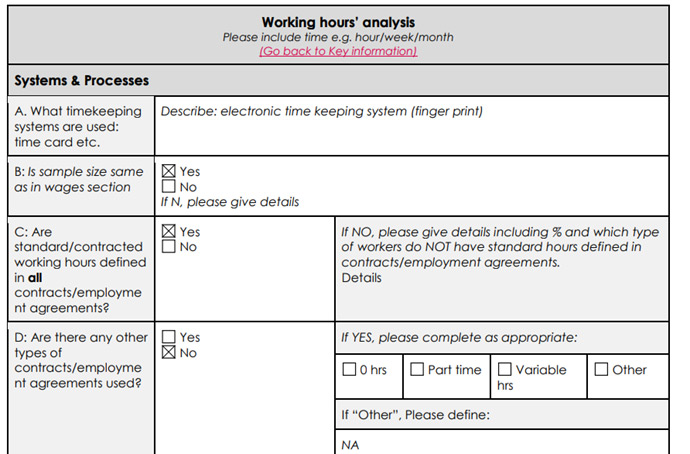
Example auditing checklist for ensuring compliance with ETI Base Code 6, Working Hours.
3. Environmental Performance Assessment
This section, Section 10B, reviews environmental practices, including waste management, emissions, and resource usage.
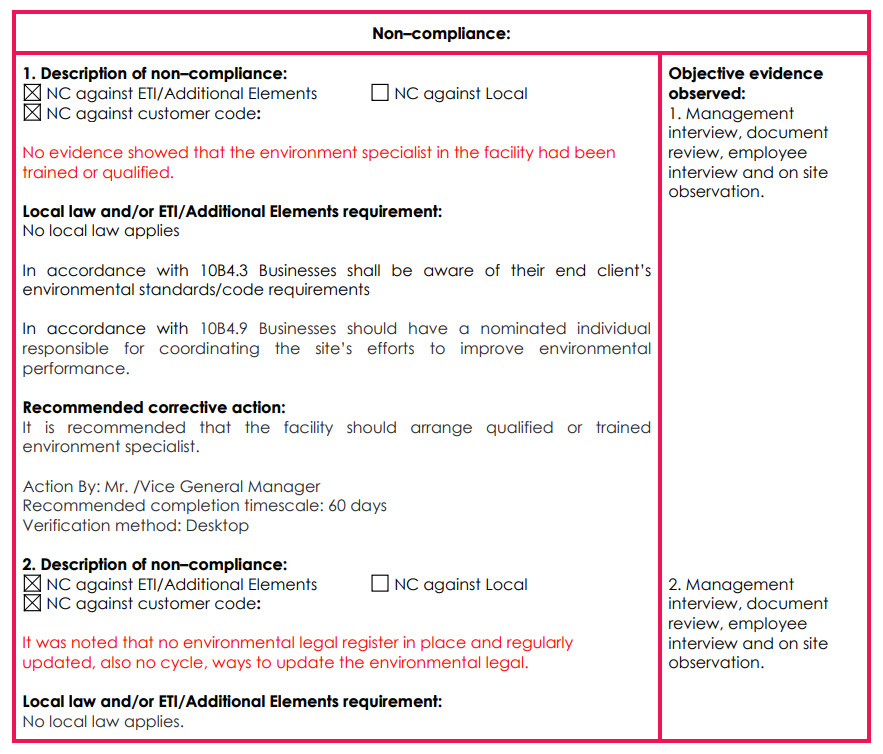
Example Non-Compliances summary of Section 10B.4, Environment 4-Pillar.This explains the non-compliances the auditor found related to environmental practices. If none are found, this checklist is left blank.
4. Business Ethics Assessment
This final assessment section, Section 10C, examines ethical practices related to anti-bribery, fair competition, and data protection.
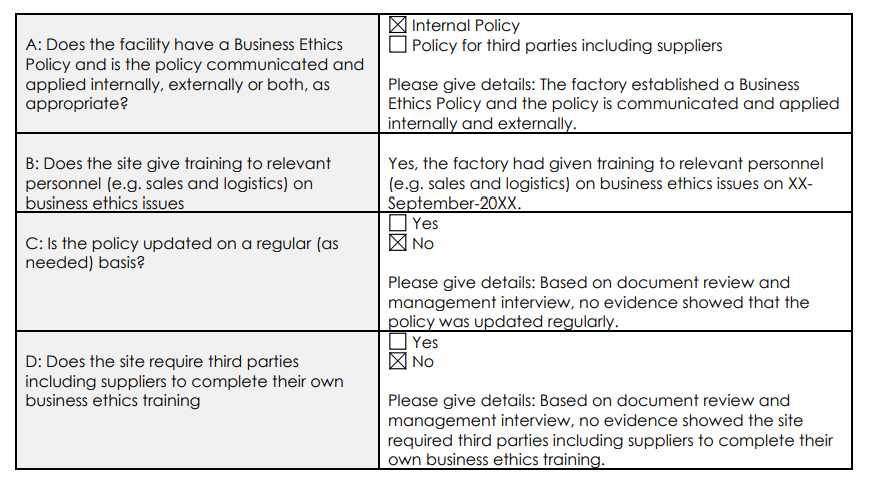
Example checklist from Business Ethics section.
5. Audit Details and Evidence
The final section of the report provides supporting documentation, such as photos and interview summaries, to validate the findings. This evidence backs up the audit results, helping you understand specific areas that need attention and providing context for the corrective actions recommended.
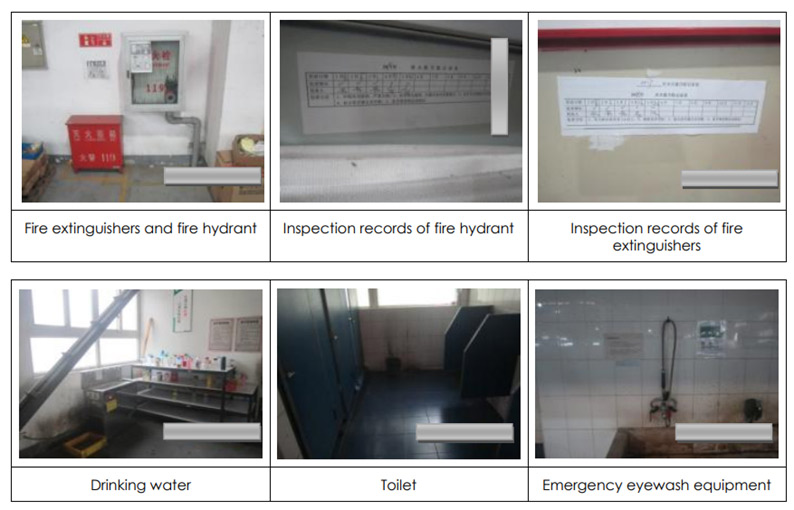
Examples of supporting photographic evidence included in the audit report.
The Details: The SMETA Audit Report Pillars
The SMETA audit report uses specific criteria and checkmarks to evaluate compliance in four core areas. Each section includes focused criteria to verify compliance with SMETA standards, offering a structured approach to ethical supply chain management.
Here’s a closer look at each section and examples of specific evaluation points.
Labor Standards
This section checks adherence to legal working conditions, fair wages, and treatment of workers. Key areas reviewed include:
- Employment Practices: Verifies that workers have written contracts, wages meet legal standards, and hours comply with laws. This includes checks on overtime policies, minimum wage, and disciplinary measures.
- Child and Forced Labor: Confirms compliance with age restrictions and the prohibition of forced labor. For example, the report ensures there is no employment of individuals under the age of 15 and that workers are not employed under coercion.
- Freedom of Association: Assesses whether workers have the freedom to form or join unions and collective bargaining is respected.
Health & Safety
This section evaluates on-site safety measures and emergency preparedness to ensure a secure work environment. Checks include:
- Fire Safety: Inspects fire exits, fire extinguishers, and conducts fire drills regularly. For instance, exits must be marked and kept clear, and drills should be documented every six months.
- Chemical Safety: Reviews handling, storage, and labeling of chemicals. Auditors check for Material Safety Data Sheets (MSDS) and emergency eyewash stations.
- Personal Protective Equipment (PPE): Confirms that PPE like masks and earplugs are provided and used correctly where necessary.
- Incident Reporting and Medical Services: Verifies that first aid kits are available and maintained, and checks records of safety incidents.
Environmental Performance
Environmental assessments cover waste management, resource usage, and compliance with regulations on emissions.
- Waste Management: Checks that waste is disposed of properly and in line with legal requirements, and that recycling practices are monitored.
- Water and Energy Consumption: Evaluates whether facilities have systems for monitoring water and energy usage, and if reduction targets are set. Facilities must monitor their energy use and report on it monthly.
- Environmental Certifications: Determines if the facility holds certifications like ISO 14000 and conducts environmental risk assessments.
Business Ethics
Business Ethics assesses policies on anti-bribery, data protection, and transparent dealings throughout the supply chain.
- Anti-Bribery Policies: Confirms that anti-bribery measures are in place, including training for employees on recognizing and preventing bribery.
- Data Protection: Checks whether there are protocols for safeguarding sensitive information, such as employee and customer data.
- Supplier Compliance: Reviews if suppliers are held to similar ethical standards, including monitoring practices and anti-corruption measures.
Interpreting the Results of the SMETA Audit Report
Interpreting the SMETA audit report involves understanding key findings, compliance metrics, and areas for improvement in each section. Here’s a quick guide on how to read the report and use its insights:
Understand Implications for Operations: Each compliance area can have direct effects on your supply chain, such as:
- Labor and Health Standards: Affect worker satisfaction and retention, impacting productivity and risk management.
- Environmental and Ethical Standards: Influence your company’s reputation and compliance with international trade requirements.
Understanding these implications – and ensuring your suppliers understand them as well – is an important first step in driving change.
Focus on Key Indicators: Each section of the report will have specific compliance metrics. Look for:
- Non-Compliance Table: Provides a summary of areas where standards weren’t met. Prioritize these areas for immediate action.
- Corrective Actions: Notes specific steps required to address any issues. Use these as actionable steps to bring your suppliers up to standard.
Identify Areas for Improvement: The report includes both non-compliance issues and observations. Focus on:
- Observations and Recommendations: These may indicate areas not in full compliance or practices that could be optimized. Addressing these can help prevent future non-compliance.
- "Good Examples": Highlighted positive practices. Use these as models to replicate across other areas of your supply chain.
Use Findings to Strengthen Compliance:
- Implement Corrective Action Plans: Work with suppliers to develop timelines and track progress for required actions.
- Set Up Regular Monitoring: Schedule follow-up audits or self-assessments to ensure ongoing adherence to standards.
- Engage with Suppliers: Foster open communication to address compliance gaps and encourage continuous improvement across the supply chain.
By leveraging these findings, you can reinforce ethical practices and ensure long-term compliance throughout your supply chain.
Conclusion: Turning Insights into Action
A SMETA audit report is more than a compliance checklist—it’s a roadmap for building a responsible and resilient supply chain. By reviewing findings carefully, addressing non-compliances, and fostering collaboration with suppliers, companies can strengthen ethical performance, enhance transparency, and align with global sustainability expectations.
When used effectively, SMETA audit insights can help transform compliance into a long-term commitment to fair labor, environmental stewardship, and business integrity.
Hits: 3684 | Leave a comment
Tags:SMETA, audit report, sustainability


















